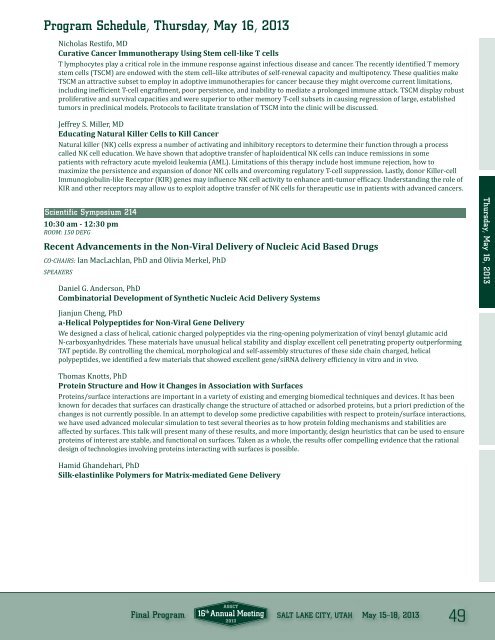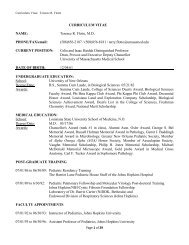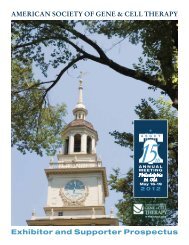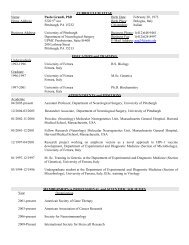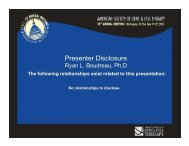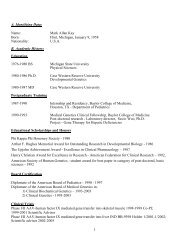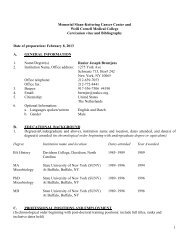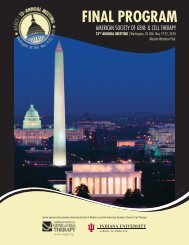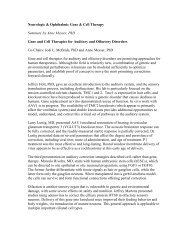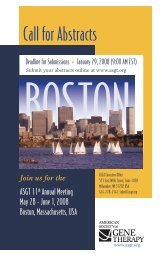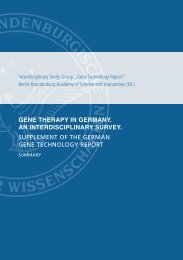Final Program - American Society of Gene & Cell Therapy
Final Program - American Society of Gene & Cell Therapy
Final Program - American Society of Gene & Cell Therapy
Create successful ePaper yourself
Turn your PDF publications into a flip-book with our unique Google optimized e-Paper software.
<strong>Program</strong> Schedule, Thursday, May 16, 2013<br />
Nicholas Restifo, MD<br />
Curative Cancer Immunotherapy Using Stem cell-like T cells<br />
T lymphocytes play a critical role in the immune response against infectious disease and cancer. The recently identiied T memory<br />
stem cells (TSCM) are endowed with the stem cell–like attributes <strong>of</strong> self-renewal capacity and multipotency. These qualities make<br />
TSCM an attractive subset to employ in adoptive immunotherapies for cancer because they might overcome current limitations,<br />
including ineficient T-cell engraftment, poor persistence, and inability to mediate a prolonged immune attack. TSCM display robust<br />
proliferative and survival capacities and were superior to other memory T-cell subsets in causing regression <strong>of</strong> large, established<br />
tumors in preclinical models. Protocols to facilitate translation <strong>of</strong> TSCM into the clinic will be discussed.<br />
Jeffrey S. Miller, MD<br />
Educating Natural Killer <strong>Cell</strong>s to Kill Cancer<br />
Natural killer (NK) cells express a number <strong>of</strong> activating and inhibitory receptors to determine their function through a process<br />
called NK cell education. We have shown that adoptive transfer <strong>of</strong> haploidentical NK cells can induce remissions in some<br />
patients with refractory acute myeloid leukemia (AML). Limitations <strong>of</strong> this therapy include host immune rejection, how to<br />
maximize the persistence and expansion <strong>of</strong> donor NK cells and overcoming regulatory T-cell suppression. Lastly, donor Killer-cell<br />
Immunoglobulin-like Receptor (KIR) genes may inluence NK cell activity to enhance anti-tumor eficacy. Understanding the role <strong>of</strong><br />
KIR and other receptors may allow us to exploit adoptive transfer <strong>of</strong> NK cells for therapeutic use in patients with advanced cancers.<br />
Scientific Symposium 214<br />
10:30 am - 12:30 pm<br />
ROOM: 150 DEFG<br />
Recent Advancements in the Non-Viral Delivery <strong>of</strong> Nucleic Acid Based Drugs<br />
CO-CHAIRS: Ian MacLachlan, PhD and Olivia Merkel, PhD<br />
SPEAKERS<br />
Daniel G. Anderson, PhD<br />
Combinatorial Development <strong>of</strong> Synthetic Nucleic Acid Delivery Systems<br />
Thursday, May 16, 2013<br />
Jianjun Cheng, PhD<br />
a-Helical Polypeptides for Non-Viral <strong>Gene</strong> Delivery<br />
We designed a class <strong>of</strong> helical, cationic charged polypeptides via the ring-opening polymerization <strong>of</strong> vinyl benzyl glutamic acid<br />
N-carboxyanhydrides. These materials have unusual helical stability and display excellent cell penetrating property outperforming<br />
TAT peptide. By controlling the chemical, morphological and self-assembly structures <strong>of</strong> these side chain charged, helical<br />
polypeptides, we identiied a few materials that showed excellent gene/siRNA delivery eficiency in vitro and in vivo.<br />
Thomas Knotts, PhD<br />
Protein Structure and How it Changes in Association with Surfaces<br />
Proteins/surface interactions are important in a variety <strong>of</strong> existing and emerging biomedical techniques and devices. It has been<br />
known for decades that surfaces can drastically change the structure <strong>of</strong> attached or adsorbed proteins, but a priori prediction <strong>of</strong> the<br />
changes is not currently possible. In an attempt to develop some predictive capabilities with respect to protein/surface interactions,<br />
we have used advanced molecular simulation to test several theories as to how protein folding mechanisms and stabilities are<br />
affected by surfaces. This talk will present many <strong>of</strong> these results, and more importantly, design heuristics that can be used to ensure<br />
proteins <strong>of</strong> interest are stable, and functional on surfaces. Taken as a whole, the results <strong>of</strong>fer compelling evidence that the rational<br />
design <strong>of</strong> technologies involving proteins interacting with surfaces is possible.<br />
Hamid Ghandehari, PhD<br />
Silk-elastinlike Polymers for Matrix-mediated <strong>Gene</strong> Delivery<br />
<strong>Final</strong> <strong>Program</strong> SALT LAKE CITY, UTAH May 15–18, 2013<br />
49


